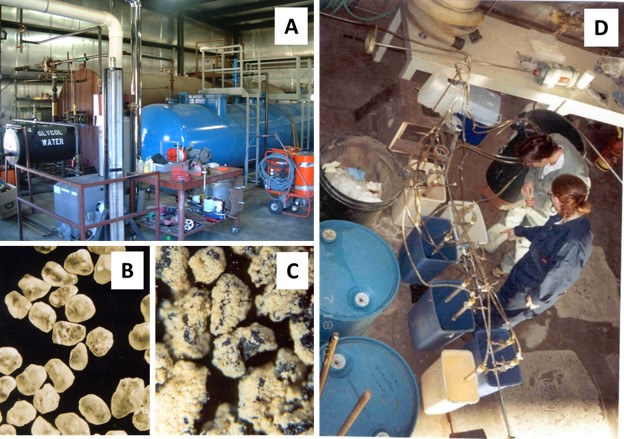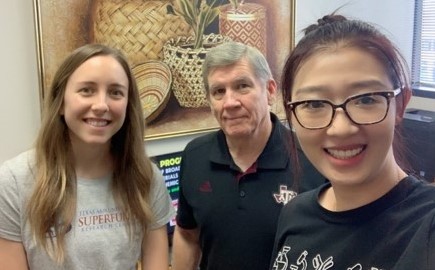Superfund Research Program
Researchers at the Texas A&M University (TAMU) Superfund Research Program (SRP) Center developed a therapeutic sorbent technology that can bind to hazardous chemicals in the body after exposure, reducing their uptake and bioavailability. Built on decades of research, these broad-acting enterosorbent materials can be added to food or water and ingested by humans and animals to reduce harmful contaminant exposures following natural disasters, chemical spills, and other emergencies.

The Problem
During environmental emergencies, people and animals can be exposed to a wide variety of harmful toxins and chemicals. In the aftermath of natural and man-made disasters, such as hurricanes and floods, complex mixtures of hazardous chemicals, including polycyclic aromatic hydrocarbons (PAHs), pesticides, polychlorinated biphenyls (PCBs), plasticizers, per- and polyfluoroalkyl substances (PFAS), high-volume solvents, and toxic metals, can contaminate drinking water and food supplies. During outbreaks of severe drought, toxic and carcinogenic aflatoxins produced by fungi can contaminate crops.
These chemicals and toxins can result in serious health effects for first responders, cleanup crews, and people and animals living nearby.
SRP Solutions
Timothy Phillips, Ph.D., leads a project developing and testing broad-acting sorbent materials to more effectively bind hazardous chemicals. These new sorbent materials build on more than 30 years of sustained work by Phillips and his research team.
Sorbents are insoluble materials, or mixtures of materials, that may be used to bind and remove contaminants from water or food. In the form of enterosorbents, they can also be used to remove toxins from the human gut.
Moving Technologies Out of the Lab
- Conducted fundamental research that informed development of sorbent materials
- Refined materials to improve binding
- Conducted lab and field tests that demonstrated utility
Phillips' early SRP-funded work provided insight into the interactions of hazardous chemicals on the surfaces of diverse materials in order to construct sorbents to remove contaminants from groundwater. Using molecular modeling techniques, his team studied and designed highly functionalized sorbents to bind to and detoxify hazardous compounds in the environment.
To develop sorbents for a specific target chemical, the researchers characterized how the chemical binds to surfaces of various materials, like clay, and defined the structural and functional characteristics that maximized the sorption process. They identified the combinations of modified clay, bonding agent, and substrate needed for optimal performance.
Building on this knowledge, the research team also constructed amended sorbents to clean up polluted water at Superfund sites. These sorbent materials were first tested in the lab, followed by scaled-up field studies to evaluate their effectiveness at removing target chemicals from an oil and water separator at a Superfund site in Montana.

(Photo courtesy of Tim Phillips)
In field tests, the team reduced the concentration of diverse PAHs, including benzo[a]pyrene, with clay sorbents. They also continued their work with highly functionalized clays to develop broad-acting sorbents to reduce exposure to harmful contaminants in food and water, including salmonella, mycotoxins such as aflatoxin and zearalenone, heavy metals such as arsenic and lead, pesticides, PCBs, and PAHs.
TAMU SRP Center researchers also recently developed hydrogel sorbents to remove long- and short-chain PFAS, including one called GenX, within a matter of hours. The sorbents are reusable and readily regenerated. Moving forward, they plan to examine the effectiveness of these sorbents for treating water contaminated with PFAS.
Testing and Validating Tools to Reduce Exposure
- Moved from environmental to biomedical applications
- Developed enterosorbents to reduce exposure and adverse health effects
- Conducted clinical trials to demonstrate safety and effectiveness

Leveraging this foundation of research, Philips shifted his attention to biomedical applications and began developing novel toxin enterosorbents to treat farm animals during contamination outbreaks and emergencies.
The enterosorbents are made of nutrient-enriched clays that are safe for consumption. When taken as therapeutic materials, they tightly bind complex mixtures of hazardous chemicals in the intestines, thereby decreasing chemical exposures and reducing the likelihood of harm to health.
Philips was the first researcher to use processed clay in animal feed to bind aflatoxin, reduce exposure, and protect against adverse health effects in animals. His research included determining that the materials were safe for animals to eat. Other research demonstrated that their use does not diminish agricultural output, such as milk quality and yield.
After determining that the technology was safe for human consumption, they began testing its effectiveness in human clinical trials in Texas, Ghana, and Kenya and demonstrated that the enterosorbent materials are effective in reducing biomarkers of aflatoxin exposure in urine and blood samples. Based on this work, a therapeutic clay was developed for detoxification purposes in people.
Commercializing New Tools and Products
- Launched two small businesses
- Further testing and commercialization through worldwide exclusive license
The enterosorbent technology developed by Phillips and colleagues launched two small businesses: Texas Enterosorbents, Inc. in 2006 and Salient Pharmaceuticals in 2007. Products based on the research are commercially available.
Their aflatoxin enterosorbent for animals is patented, produced, and sold by BASF. Based on Phillips' work, a commercial therapeutic clay is currently available online from Premiere Research Labs.

Phillips and SRP trainees Sara Hearon, left, and Meichen Wang, right, are developing enterosorbents that can be added to food or water to reduce exposure to harmful chemicals.
(Photo courtesy of Tim Phillips)
The team is now developing broad-acting enterosorbent materials that can be added to food and water to reduce exposure to harmful mixtures of contaminants following natural disasters and other emergencies. They demonstrated that these enterosorbent materials can significantly decrease the toxicity of harmful contaminants and mixtures using lab studies with Hydra vulgaris, an organism with very low tolerance for hazardous substances.
Texas EnteroSorbents, Inc. has been granted a worldwide exclusive license through TAMU for further testing and commercialization of this new technology, patent pending. The team aims to investigate and develop these materials so they can be delivered to first responders and vulnerable populations through food, vitamins, snacks, tablets, or drinking water during emergencies and natural disasters to reduce the toxicity of harmful contaminants and to protect human and animal health.
Originally funded in 1989, the TAMU SRP Center spent 20 years advancing research on methods to assess the health hazards of contaminants at Superfund sites, including detecting chemicals in the environment, improving exposure assessments, understanding the underlying mechanisms by which these contaminants cause disease, and developing chemical intervention strategies to reduce exposure. Re-funded in 2017, the TAMU SRP Center now focuses on developing comprehensive tools and models for addressing exposure to mixtures during environmental emergencies, such as hurricanes or chemical spills.


